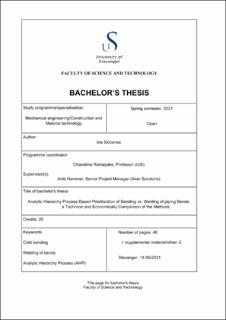| dc.description.abstract | Welding of bends to manufacture bent pipes is a well-known method used worldwide. Cold bending is a competing manufacturing method and has its advantages and disadvantages.
The purpose of this thesis is to compare cold bending and welding of bends, both technically and economically. Analytic Hierarchy Process (AHP), requirements, standards and data from a reference project were used in the prioritizing between the manufacturing methods. During the study, several criteria were taken into consideration, and it was attempted to compare the different manufacturing methods as thorough as possible within the time given.
Requirements
Of the standards and requirements considered for the comparison, some differences between the two manufacturing methods appeared. Regarding NDT, the standards overall require more NDT for welding of bends than for cold bending. Note that generally there are written more requirements, information and limitations concerning welding in standards than about cold bending. It can be discussed if that favours cold bending or not.
Limitations
Cold bending as a manufacturing method to fabricate pipe bends has some limitations regarding pipe dimensions and bending radii. If there are lack of space (radii < 2D) and bigger pipe diameters (nominal pipe diameter > 8’’) are needed, welding of bends is the preferred alternative.
Some are sceptic to use cold bending to manufacture bent pipes if the service is defined sour and/or low temperature systems. Tests have been conducted to qualify 6Mo and Duplex, Super-duplex cold bent pipes to be used in sour service conditions. Both tests passed with given partial pressure, and with no signs of sour service cracking (i.e., SSC/SCC) or corrosion. For low temperature service, cold bent Duplex materials are qualified down to -75oC. Recommended use of Duplex materials is down to -50oC. Low temperature Carbon steel pipes can’t be bent as they lose their low temperature properties.
Economically
Analysis and calculations performed for this thesis show that cold bending has a significant lower cost and fabrication time per unit than welding, when post bend heat treatment is not required. The preferences change slightly when comparing with different types of material and pipe dimensions (pipe schedules, and nominal pipe diameters). | |
